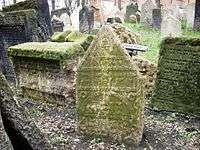David Gans
| David Gans (David ben Shlomo Gans) | |
|---|---|
|
Tombstone of David Gans in Prague | |
| Born |
1541 Lippstadt |
| Died |
25 August 1613 Prague |
| Resting place | Old Jewish Cemetery of Prague, Josefov, Prague |
| Religion | Judaism |
| Parent(s) | Shlomo ben Seligman |
David Gans (Hebrew: דָּוִד בֶּן שְׁלֹמֹה גנז; 1541–1613), also known as Rabbi Dovid Solomon Ganz, was a Jewish chronicler, mathematician, historian, astronomer and astrologer. He is the author of "Tzemach David" (1592).
Biography
David was born in Lippstadt, in what is now North Rhine-Westphalia, Germany. His father, Shlomo, was a moneylender. He studied rabbinical literature in Bonn and Frankfurt am Main, then in Kraków under Moses Isserles.[1]
Later he attended the lectures of the Maharal of Prague and of his brother, Rabbi Sinai. They introduced philosophy, mathematics, and astronomy into the circle of their studies, and from them Gans received the impulse to devote himself to these branches of science. He lived for a time at Nordheim (where he studied Euclid), passed several years in his native city of Lippstadt, and then in about 1564 settled at Prague. There he came into contact with Kepler and Tycho Brahe, and took part for three consecutive days in astronomical observations at the Prague observatory. He also carried on a scientific correspondence with Johann Müller (Regiomontanus), and was charged by Tycho Brahe with the translation of the Alfonsine Tables from Hebrew into German.[1]
His grave in Prague is marked with a Star of David and a goose (German: Gans meaning goose in German). This is the first time a Star of David was officially used as Jewish community emblem.[2]
Writings
Among Gans's works the most widely known is his history entitled Tzemach David, published first at Prague, in 1592. It is divided into two parts, the first containing the annals of Jewish history, the second those of general history. The author consulted for the second part of his work the writings of Cyriacus Spangenberg, Laurentius Faustus, Hubertus Holtzius, Georg Cassino, and Martin Borisk. Gans's annals are memorable as the first work of this kind among the German Jews. In his preface to the second volume the author tries to justify writing about a "profane" subject like general history, and demonstrated that it was permitted to read history on Shabbat. Tzemach David was published in many editions. To the edition of Frankfort-on-the-Main, 1692, David ben Moses Rheindorf added a third part containing the annals of that century, which addition has been retained in later editions of the Tzemach. The first part of Gans's work, and extracts from the second, were translated into Latin by Wilhelm Heinrich Vorst (Leyden, 1644). It was translated also into Yiddish by Solomon Hanau (Frankfort-on-the-Main, 1692).[1]
Gans was also the author of: Gebulat ha-Eretz, a work on cosmography, which is in all probability identical with the Zurat ha-Eretz, published at Constantinople under the name of "David Avazi" ("Avaz" means "goose" in Hebrew, a reference to the surname "Gans", which means "goose" in German); Magen David, an astronomical treatise, a part of which is included in the Nechmad ve'naim mentioned below; the mathematical works Ma'or ha-Ḳatan, Migdal David, and Prozdor, which are no longer in existence; Nechmad ve'naim dealing with astronomy and mathematical geography, published with additions by Joel ben Jekuthiel of Glogau at Jessnitz, 1743. This work is divided into 12 chapters and 305 paragraphs. In the introduction the author gives a historical survey of the development of astronomy and mathematical geography among the nations. Although acquainted with the work of Copernicus, Gans followed the Ptolemaic system, attributing the Copernican system to the Pythagoreans. He also ventures to assert that the prophet Daniel made a mistake in computation. A Latin translation of the introduction, and a résumé made by Hebenstreit, are appended to the Nechmad ve'naim.[1]
References
- 1 2 3 4
 One or more of the preceding sentences incorporates text from a publication now in the public domain: Singer, Isidore; et al., eds. (1901–1906). "GANS, DAVID BEN SOLOMON BEN SELIGMAN". Jewish Encyclopedia. New York: Funk & Wagnalls Company. Retrieved March 19, 2013.
One or more of the preceding sentences incorporates text from a publication now in the public domain: Singer, Isidore; et al., eds. (1901–1906). "GANS, DAVID BEN SOLOMON BEN SELIGMAN". Jewish Encyclopedia. New York: Funk & Wagnalls Company. Retrieved March 19, 2013. - ↑ What's new with Prague's Old-New Synagogue
External links
| German Wikisource has original text related to this article: |
